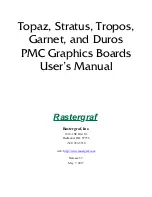
Glossary
|
|
ELSA GLADIAC
|
38
EN
쎲
Composite video –
A method of
transferring video data signals, where the
signals for
➞
chrominance and
➞
luminance are combined (also called
FBAS).
쎲
Cube environment mapping –
In order
to represent realistic and undistorted
reflections of the environment onto an
object, six
➞
Textures are viewed as the
surfaces of a cube. The textures show the
environment from the perspective of the
object. This gives the impression that the
environment is being reflected by the
object. CEM is an extension of sphere
environment mapping. The advantage of
CEM is that no new textures need to be
calculated when the observer's point of
view changes and the texture is not
distorted.
쎲
D/A converter –
Digital/analog
converter: A signal converter that converts
digital input to analog output.
쎲
DDC –
Abbreviation for display data
channel. A special data channel through
which a DDC-capable monitor can send its
technical data to the graphics board.
쎲
DirectColor –
A generic term for
➞
TrueColor,
➞
RealColor and
➞
HighColor. In this case, the value stored
in the video RAM is not translated but is
passed directly to the D/A converter. This
means that the full color information must
be saved for each pixel.
쎲
Double buffering –
Describes the
presence of doubled display memory. This
permits the next image to be generated
first in the invisible background. As soon
as it is completely constructed, the
monitor display switches to the image that
has been residing in the background and
the preparation of the next image begins
on the other side.
쎲
DPMS –
Abbreviation for VESA display
power management signalling. This
allows several stages of monitor power
saving mode. The graphics boards
described in this manual support VESA
DPMS.
쎲
DRAM –
Abbreviation for Dynamic
Random Access Memory. Dynamic
random access memory with direct
access.
쎲
EDO-RAM –
Abbreviation for extended
data output random access memory (hyper
page mode). EDO-RAM is especially
advantageous in graphics boards because
the most recently required data remains
held in memory. Image rendering involves
multiple consecutive read access of
similar data, so EDO-RAM results in
significantly faster speeds.
쎲
FBAS –
➞
Composite video
쎲
FCC –
The FCC radiation standard states
that this device has been tested and meets
the requirements for digital class B
devices in accordance with section 15 of
the guidelines as provided by the
American Federal Communications
Commission (FCC).
쎲
FIFO method –
Abbreviation for first in,
first out: A system used in batch
processing and queues, in which the first
arriving signal is processed first.
21663_DE_0300.book Seite 38 Montag, 10. April 2000 12:22 12







































